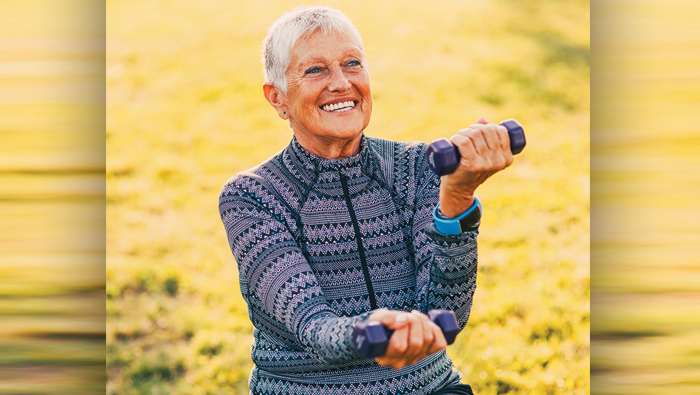
Forget that “fat-burning” setting on the treadmill. According to a new study published in Obesity, strength training is better at helping people lose belly fat compared with cardio. While aerobic exercise burns both fat and muscle, weight lifting burns almost exclusively fat. And don’t worry about turning into a bulky, bodybuilding champion if you start weight lifting (unless that is your goal). There are many factors involved to develop a body like that, but you can develop an exercise plan that incorporates weight training without causing massive muscle growth.
According to research from Harvard Medical School, a general 30-minute strength training session burns an average of 90 calories (180 calories per hour) for a 125-pound person, 112 calories (224 calories per hour) for a 155-pound person and 133 calories (266 calories per hour) for a 185-pound person. So, the heavier you are, the more calories you will burn during a weight-training session.
Muscle growth also equals a boost in metabolism. Lifting weights increases the number of calories you burn while you are sitting on the couch or in your office chair. That’s because, after each strength workout, your muscles need energy to
repair their fibers. In fact, researchers found that when people did a total-body workout with just three big-muscle moves, their metabolisms were raised for 39 hours afterward. They also burned a greater percentage of calories from fat compared with those who didn’t lift.
The weightlifting moves that use multiple muscles are the ones that build the most muscle. You can try these five moves with no added weight (using only body weight for resistance). Then start adding weights for a bigger gain:
- Squats
- Lunges
- Deadlifts
- Pull-ups
- Push-ups
Pumping iron can also reduce your risk of heart disease and was approved as a healthy form of exercise for those at risk from the American Heart Association. A study in the Journal of Strength and Conditioning found that those who lift weights are less likely have heart disease risk factors such as a large waist circumference, high triglycerides, elevated blood pressure and elevated glucose levels.
Another study conducted by researchers in Brazil found that although the heart rate increased in patients during heavy bouts of training, their blood pressure and resting heart rate were significantly lower the following morning.
As you age, you are also at risk of losing bone mass. This factor increases your chances of suffering bone fractures. Postmenopausal women are at a greater risk for osteoporosis because the body no longer secretes estrogen. Resistance training is an excellent way to combat loss of bone mass, and it decreases the risk of osteoporosis. Women who had their blood tested after 16 weeks of resistance training showed increased levels of osteocalcin (a marker of bone growth) by 19 percent.
Exercise, in general, is an excellent way to manage stress. You always feel better and sleep better those days that you exercise, right? Research has consistently shown that those who regularly strength train tend to manage stress better and experience fewer adverse reactions to stressful situations compared to those who do not exercise. An added bonus – weightlifting has also recently been discovered to improve memory and cognitive function in older adults.
Another benefit of a good workout – better sleep. According to the National Sleep Foundation, as little as 10 minutes of aerobic exercise can dramatically improve the quality of your sleep. What’s more, those who exercise may reduce their risk for developing troublesome sleep disorders such as sleep apnea and restless leg syndrome.
Between the ages of 30 and 50, women are likely to lose 10 percent of their body’s total muscle. Unfortunately, over time, this muscle is likely to be replaced by fat. And that increases your waist size because one pound of fat takes up 18 percent more space than one pound of muscle. So – get moving! It’s never too late to start an exercise program that can help combat the fat! By incorporating weight training, you will be helping your body – both inside and out!





